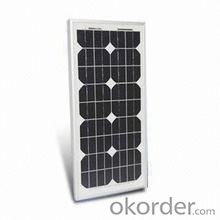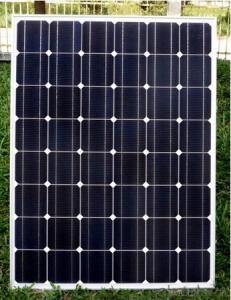Poly Solar Panel 295W B Grade with Cheapest Price
- Loading Port:
- Shanghai
- Payment Terms:
- TT OR LC
- Min Order Qty:
- 100 watt
- Supply Capability:
- 10000 watt/month
OKorder Service Pledge
OKorder Financial Service
You Might Also Like
Item specifice
Poly Solar Panel 295W B Grade with Cheapest Price
Product description
A solar cell, or photovoltaic cell (in very early days also termed "solar battery"[1] – a denotation which nowadays has a totally different meaning, see here), is an electrical device that converts the energy of lightdirectly into electricity by the photovoltaic effect, which is a physical and chemical phenomenon.[2] It is a form of photoelectric cell, defined as a device whose electrical characteristics, such as current, voltage, or resistance, vary when exposed to light. Solar cells are the building blocks of photovoltaic modules, otherwise known as solar panels.
Solar cells are described as being photovoltaic irrespective of whether the source is sunlight or an artificial light. They are used as a photodetector (for example infrared detectors), detecting light or other electromagnetic radiation near the visible range, or measuring light intensity.
A photovoltaic (in short PV) module is a packaged, connected assembly of typically 6×10 solar cells. Solar Photovoltaic panels constitute the solar array of a photovoltaic system that generates and supplies solar electricity in commercial and residential applications. Each module is rated by its DC output power under standard test conditions, and typically ranges from 100 to 365 watts. The efficiency of a module determines the area of a module given the same rated output – an 8% efficient 230 watt module will have twice the area of a 16% efficient 230 watt module. There are a few solar panels available that are exceeding 19% efficiency. A single solar module can produce only a limited amount of power; most installations contain multiple modules. A photovoltaic system typically includes a panel or an array of solar modules, a solar inverter, and sometimes a battery and/or solar tracker and interconnection wiring.
Application
Business
Home
Industry
Large project
Feature
1. A grade high efficiency solar cells.
2.TUV/UL/CE/CEC etc
3.Fast shippment
4.25 years warranty
5.OEM/ODM
Packaging
28pcs into one carton
Shipping
Material in stock can be produced (procedure 5-20days) right away after pre-payment confirmation. COSCO Mearsk MSCship to worldwide for safe shipping, don't worry about package damage or loss. It takes about 15-40 days to worldwide, Please note us your contact details include your phone number for easy contacting from shipping company officer.
- Q:Can solar panels be used in areas with high levels of shade or obstruction?
- Solar panels can still be used in areas with high levels of shade or obstruction, but their efficiency and performance may be significantly reduced. Shade or obstructions like tall buildings, trees, or nearby structures can block sunlight, preventing the panels from receiving the necessary amount of light to generate optimal electricity. However, there are advanced technologies and design techniques available that can mitigate the impact of shading, such as using micro-inverters, optimizers, or tilting and positioning the panels to maximize sunlight exposure. Overall, while solar panels can still function in shaded areas, it is crucial to assess the level of shading and its potential impact on energy production before installation.
- Q:I am learning all about heat radiation in Physics. There is a question I am doing about Solar panels. It asks, why do glass covers improve the efficient of solar panels? I dont really understand. How do they?? thanks :D x
- the glass has an anti-reflective coating that helps the panel absorb more light (to convert to electricity) thant it would if the glass were not there. the other purpose of glass is to retain heat and strengthen the panel
- Q:Aren't batteries bad for the environment?Toxic?Expensive? With small solar panels phones, iPod's, laptops other small electronics could be smaller, slimmer, more efficient cost people less to charge every day. Maybe a small battery inside as a backup and to store the Solar energy for night time. But overall, batteries should be optional. So big question:Why aren't electronics being produced with solar panels?
- Actually, I have gone through quite a few solar powered radios-though they had rechargeable batteries. Still have a solar powered flashlight. Leave 'em out in the sun for a few hours and your get an hour of radio, or a day or so of light. That doesn't get rid of the batteries thought (Which are built-in rechargables)
- Q:Can solar panels be installed on satellites?
- Yes, solar panels can be installed on satellites. In fact, solar panels are commonly used to provide power to satellites in space.
- Q:If i wanted to get a 5 KW solar Panel does it mean it produces 5KW a day/hour/year!?!?i need 2555.35KW a week and i don't know how many or what kind of solar panels i need.Please somebody help me
- First, learn the difference between kilowatts and kilowatt hours, and all shall be made clear.
- Q:When you consider that solar panels will not produce enough electricity in their service life to cover their cost should we subsidize them anyway? that much of the cost of a solar panel is the energy to manufacture, install, transport and maintain them. Shouldn't the market determine whether they are worth installing?Is subsidizing them taking money away from research that could be spent on more viable alternatives?Should we be taxed to pay for others solar panels when they don't work?
- so, you think of that the perfect concept is to easily save specializing in oil and to not attempt to compete? each CON i've got talked to on right here is going on and on approximately how green power is a foul concept? yet, right this is China, with a centred purpose and fairly making it happen... ask your self how far we'd be interior the U. S. without the cons scuffling with us each step of how... how's that buggy whip enterprise going cons? that's what we recommend as quickly as we are saying owing to Republicans do you think of green power won't happen? China's already doing it... we are able to the two capture up, or supply up... and supply up has a huge unempmloyment value related to it...
- Q:Can solar panels be installed on a historic building?
- Yes, solar panels can be installed on a historic building. However, the installation process may require careful planning and consideration to ensure minimal visual impact and preservation of the building's historical integrity. Collaboration with preservation experts, architects, and local authorities is crucial to finding a suitable solution that balances renewable energy goals with the preservation of the building's historic value.
- Q:Online stores selling solar photo-voltaic generation kits gives specs indicating the power generation capability of the system. For example, Solar World Grid-Tie Solar Electric System with 245W Panels PV Powered PVP2000 Inverter, .2 to 2.4 kW. This seems to indicate that the system can generate .2 to 2.4 kW. Is that per day? Per month? I'm trying to calculate the return on investment, but can't because I don't know how much power a system such as this will generate in a month.
- As Ed said, that .2 kW is an instantaneous rating in bright sun. The way to do this right is to consult the maps here rredc.nrel /solar/old_data/nsr... to find the number of equivalent sun-hours your location gets per day. Select, Average, Annual, Flat plate tilted south at latitude. A map will come up. For northern California, it shows 5 equivalent sun hours per day, for example. If the system is .2 kW, then .2 x 5 = 6.0 kWh of energy the system will generate per day, on average. That takes into account cloudy days, short winter days, long summer days, everything. The 2.4 kW system would give double that, obviously. But that's an example, based on a specific location. Phoenix would do better, Seattle would do worse.
- Q:ok so when a solar panel is marked as a certain wattage dose that mean it makes that much in a day in an hour or constant, dose it still work at night or what ? is it worth it or is it more of a pain? can some one tell me what all the watts and volts mean ?? and can some one tell me what a kilowhat is in refrence to some thing i understand like howmany loads of laundey can you do wt a watt? i need help understanding this stuff?
- Quick okorder .
- Q:Does a solar panel work under a full moon a tiny bit, or not at all? Likewise, if you used mirrors or lenses the concentrate sunlight, is there a maximum to how much a solar panel can handle?
- solar panels should be used where the sunlight is abundant,you can use mirrors or lenses the concentrate sunlight,solar panels will absorb more light.
1. Manufacturer Overview |
|
|---|---|
| Location | |
| Year Established | |
| Annual Output Value | |
| Main Markets | |
| Company Certifications | |
2. Manufacturer Certificates |
|
|---|---|
| a) Certification Name | |
| Range | |
| Reference | |
| Validity Period | |
3. Manufacturer Capability |
|
|---|---|
| a)Trade Capacity | |
| Nearest Port | |
| Export Percentage | |
| No.of Employees in Trade Department | |
| Language Spoken: | |
| b)Factory Information | |
| Factory Size: | |
| No. of Production Lines | |
| Contract Manufacturing | |
| Product Price Range | |
Send your message to us
Poly Solar Panel 295W B Grade with Cheapest Price
- Loading Port:
- Shanghai
- Payment Terms:
- TT OR LC
- Min Order Qty:
- 100 watt
- Supply Capability:
- 10000 watt/month
OKorder Service Pledge
OKorder Financial Service
Similar products
New products
Hot products
Related keywords




























